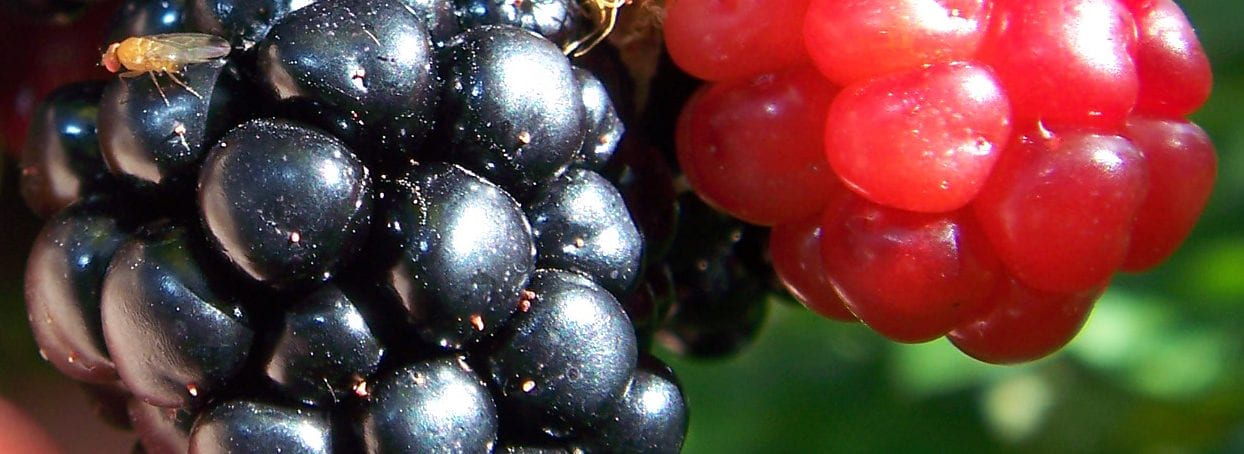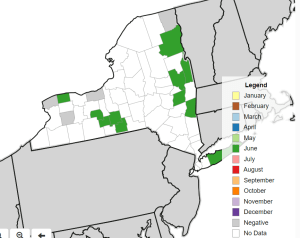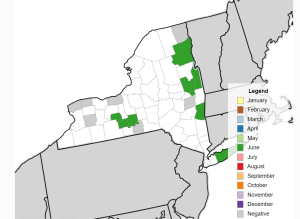First catch was reached today in Albany County, with 7 males on sticky traps and 5 females and 5 males on drowning jar traps. All traps were in raspberries with ripe fruit. Thank you to Natasha Field for checking those traps!
We also reached first trap catch in Tioga county, 2 males and 3 females found in drowning traps in blueberries. Thank you to Anya Osatuke for checking that trap!
Here are some management recommendations (Copied from https://fruit.cornell.edu/spottedwing/management/)
- Excellent sanitation to reduce SWD populations.Fruit should be harvested frequently and completely to prevent the buildup of ripe and over-ripe fruit. Unmarketable fruit should be removed from the field and either frozen, “baked” in clear plastic bags placed in the sun, or disposed of in bags off-site. This will kill larvae, remove them from your crop, and prevent them from emerging as adults.
- Canopy and water management to make the environment less favorable.Prune to maintain an open canopy, increase sunlight and reduce humidity. This will make plantings less attractive to SWD and will improve spray coverage. Repair leaking drip lines and avoid overhead irrigation when possible. Allow the ground and mulch surface to dry before irrigating. Female flies prefer to lay eggs in shaded locations, away from heat and sunlight.
- Exclusion netting to prevent SWD infestation of fruit. Insect exclusion netting can be installed prior to the arrival of SWD to create a physical barrier between the insects and the fruit. Netting is woven polyethylene yarn, available in different gauges (i.e. hole size). Field trials have demonstrated that 80 gram netting (1.0 x 0.6 mm) is effective for exclusion, but 60 gram netting is not. Netting is 100% effective if effectively managed, meaning netting is installed before SWD arrives, no holes are present, and nets are routinely inspected and maintained throughout the season. Netting also provides protection from other damage, such as birds, high wind, and hail. For more detailed information, see Thinking exclusion? on the NYSIPM Spotted Wind Drosophila blog.
- Insecticide sprays will kill SWD adults and thereby reduce egg laying:Insecticide treatments should begin when fruit are ripe or ripening and SWD are found in traps. Follow regional monitoring alerts about the first SWD trap catch nearest your farm or consider monitoring SWD traps in your susceptible fruit crops. Keep records of when susceptible fruit crops begin to ripen. Treatments should be applied at least every seven days and repeated in the event of rain. Choose the effective insecticides with pre harvest intervals that work for your picking schedule. Rotate insecticides according to their modes of action. Use the most effective insecticide when you first initiate your spray program — research shows this delays the build up of SWD over time.
Quick reference guides:
Check the Cornell Guidelines for the latest list of approved pesticides in NYS. Special needs labels and 2(ee) recommendation labels are being sought for NY berries and cherries. Always read and follow the pesticide label instructions and have the special needs or 2(ee) labels with you when applying.
- Regular fruit sampling:At least 100 fruit per block per harvest should be observed for infestation. Talk to your local CCE agent about a monitoring program. Fruit can be inspected for evidence of larval feeding. Small holes in berries where the eggs were laid may leak juice when the berry is gently squeezed; this is especially diagnostic on blueberry. Infested red raspberry fruit may leave a red juice stain on the berry receptacle when the fruit is picked. Fruit with small indents or bruises where the surface appears to have flattened or deflated may be infested — typical of SWD infestation in blueberry, strawberry, and cherry. A salt flotation method, immersing fruit in a solution of 1 Tbsp. (14.8 cc) table salt per 1 cup (236.6 ml) water, may cause larvae to emerge from fruit and die so they can be easily quantified. At least 100 fruit per block per harvest should be observed for infestation. Suggested methods were adapted for NY growers in Guidelines for Checking Fruit for SWD Larvae in the Field (pdf).
- Cool berries immediately:Chilling berries immediately after harvest to 32o – 33o F will slow or stop the development of larvae and eggs in the fruit. U-Pick customers should be encouraged to follow this strategy to improve fruit quality at home.



